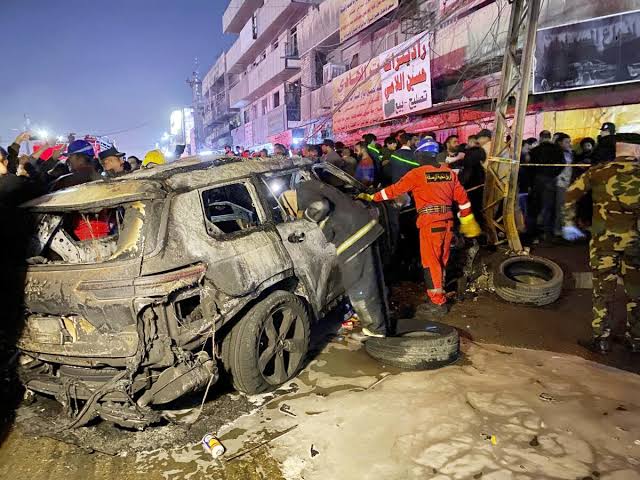US drone strike in Baghdad kills high-ranking Hezbollah militia leader

A U.S. drone strike blew up a car in the Iraqi capital Wednesday night, killing a high-ranking commander of the powerful Kataib Hezbollah militia who is responsible for “directly planning and participating in attacks” on American troops in the region, the U.S. military said Wednesday.
The precision blast hit a main thoroughfare in the Mashtal neighbourhood in eastern Baghdad, attracting a crowd as emergency teams picked through the wreckage. It came amid roiling tensions in the region, and will likely further anger Iraqi government leaders, who U.S. officials said were not notified in advance of the strike.
Security forces closed off the heavily guarded Green Zone, where a number of diplomatic compounds are located, and there were concerns about social media postings urging protesters to storm the U.S. embassy.
There were conflicting reports on the number of those killed, with U.S. officials saying the initial assessment was one, and saying there were no civilians hurt or killed. But two officials with Iran-backed militias in Iraq said that three died, including Wissam Muhammad Sabir Al-Saadi, known as Abu Baqir Al-Saadi, the commander in charge of Kataib Hezbollah’s operations in Syria. Kataeb Hezbollah later announced his death “following the bombing of the American occupation forces” in a statement.
Those officials spoke on condition of anonymity because they weren’t authorized to speak to journalists.
In a statement, U.S. Central Command said “there are no indications of collateral damage or civilian casualties at this time.” It added that the U.S. “will not hesitate to hold responsible all those who threaten our forces’ safety.”
The strike — which came at 9:30 p.m. local time — is certain to inflame already seething relations between Washington and Baghdad. It comes just days after the U.S. military launched an air assault on dozens of sites in Iraq and Syria used by Iranian-backed militias and the Iranian Revolutionary Guard in retaliation for a drone strike that killed three U.S. troops and injured more than 40 others at a base in Jordan in late January.
The U.S. has blamed the Islamic Resistance in Iraq, a broad coalition of Iran-backed militias, for the attack in Jordan. President Joe Biden and other top leaders have repeatedly warned that the U.S. would continue to retaliate against those responsible for the Jordan attack. And officials have suggested that key militia leaders would be likely targets.
The Islamic Resistance in Iraq has regularly claimed strikes on bases housing U.S. troops in Iraq and Syria against the backdrop of the ongoing Israel-Hamas war, saying that they are in retaliation for Washington’s support of Israel in its war in Gaza that has killed more than 27,000 Palestinians, according to the Health Ministry in the Hamas-run territory.
There have been nearly 170 attacks on U.S. forces in Iraq and Syria since Oct. 18, but the latest drone strike in Jordan — the only one in that country so far — was the first to take American troops’ lives. The U.S., in response, has struck back about a half dozen times since Oct. 27, targeting weapons storage sites, command and control centers, training facilities and other locations used by Iran’s Islamic Revolutionary Guard Corps and Iranian-backed groups, including Kataib Hezbollah.
Wednesday’s U.S. strike in Iraq’s capital drew comparisons to the 2020 drone strike in Baghdad that killed Iran’s Quds Force leader Gen. Qassem Soleimani, in response to attacks on U.S. bases there and an assault on the U.S. Embassy in Baghdad. That bombing also killed Abu Mahdi al-Muhandis, deputy commander of Iran-backed militias in Iraq known as the Popular Mobilization Forces. And it enraged Iraqi leaders, triggering demands for the withdrawal of U.S. forces from the country.
Kataib Hezbollah had said in a statement that it was suspending attacks on American troops to avoid “embarrassing the Iraqi government” after the strike in Jordan, but others have vowed to continue fighting.
On Sunday, the Islamic Resistance in Iraq claimed a drone attack on a base housing U.S. troops in eastern Syria killed six fighters from the Syrian Democratic Forces, a Kurdish-led group allied with the United States.
The latest surge in the regional conflict came shortly after Israeli Prime Minister Benjamin Netanyahu on Wednesday rejected terms proposed by Hamas for a hostage-release agreement that would lead to a permanent cease-fire, vowing to continue the war until “absolute victory.”
Also on Wednesday, the media office of the Houthi rebels in Yemen reported two airstrikes in Ras Issa area in Salif district in Hodeida province.




